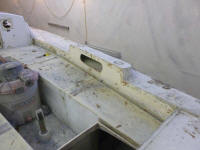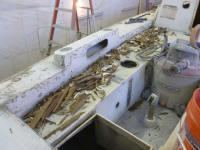
110 Cookson Lane | Whitefield, ME 04353 | 207-232-7600 | tim@lackeysailing.com
I started back where I left off, with the cockpit coamings, and, in the same manner, removed the remnants on both sides--a slow but ultimately effective process.
After cleaning up from that job, I headed below with the vague notion of removing the water tank from beneath the starboard settee and ultimately beginning surface prep work in the cabin. However, some nagging questions in my mind about the condition of the port hull, particularly in way of the midships repair, caused me to redirect my attention to a general hull survey.
Beginning outside, I sounded the entire hull above the waterline, most areas of which were cored. While I'd done this partially a couple weeks earlier, after exposing the hull repair, I'd not been happy with my results, and as time went on and additional information continued to arise, it was time to truly determine what we were up against. During hull paint removal, I'd noticed additional cracking, and also some signs of hull flex that tended to indicate at least partial debonding of the core, but it took all the factors combined with some of what I found following the toerail removal to start bringing together the whole picture.
Sounding results, particularly on the port side, were such that I needed to drill into the core from inside the boat in order to gain insight as to its condition, and the overall condition of the structure, particularly where repaired. With a large drill bit, I drilled a series of test holes, extending through the inner skin and core, but not compromising the outer skin. Fortunately, with most of the interior removed there was good access. Starting low in the cored area, I drilled one, then another, and eventually five holes in the port midships section, all of which revealed core material that was damp, though still holding together, but the bond between the core and the skins--both inner and outer--seemed tenuous at best. Interestingly, within the same small test holes I could find, in some areas, both foam and balsa core, suggesting that perhaps the repair had been completed with leftover materials or whatever could be dredged up. The foam was just as wet as the balsa.
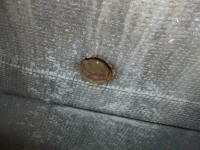
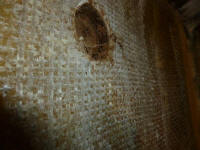
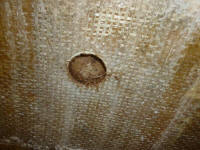
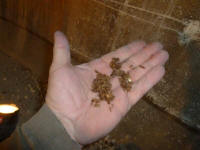
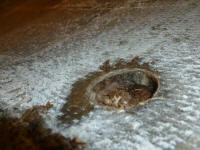
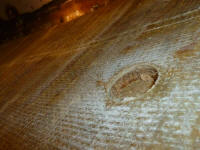
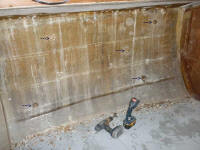
Alarmed by what I was finding--though on some level I'd been expecting this, if hoping otherwise--I extended my test sampling throughout the boat in order to determine the scope of the issue. A couple test holes in the head compartment revealed that the core in that area--also within the general boundaries of the exterior repair--was in similar dampened, unbonded condition.
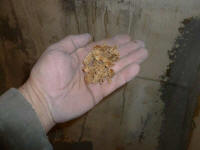
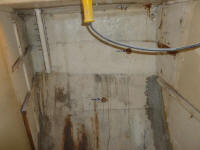
One place I'd actually been expecting core problems was just aft of amidships on the port side, in way of the exhaust outlet. With the outlet piercing the cored hull at the waterline, it seemed a likely place for water infiltration, and my single test hole a bit lower than the exhaust bore this expectation out.
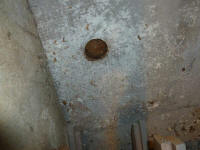

I couldn't access a large section of the port hull located behind the quarterberth liner, but generally the worst of the sounding results ended roughly in way of the exhaust, so I hoped that I wouldn't have to work in the liner-ed area. For now, I reserved that concern and moved on to other parts of the boat.
In the forward cabin, test holes on both sides revealed dry core, fortunately. Similarly, a test hole on the starboard hull amidships also revealed dry, sound core. I only drilled a single test hole on each side of the v-berth since I'd no information suggesting that I needed more; sounding both inside and out seemed to indicate that the major problems ended aft of here (port side), and the starboard sample was more due diligence than anything.
Other areas on the starboard side were more inaccessible thanks to various cabinetry, but since sounding results on this side had been much more in keeping with my expectations, I didn't harbor any particular concerns about the starboard side.
Port V Berth
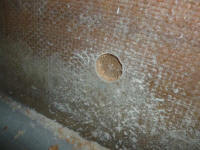
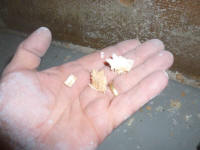
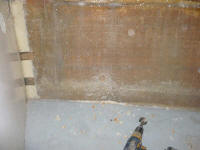
Starboard V Berth

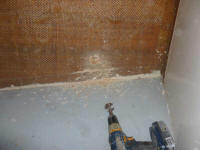
However, the additional test holes--despite the dry core--did reveal signs of poor bonding between the core and outer hull skin, with voids visible in some of the test holes, and reinforced by sounding results that also suggested lack of bonding in some areas. It appeared to be that these were latent defects, or construction voids, and not uncommon (or perhaps even common) given the construction practices of the day. As such, the presence of these voids did not alarm me, and had probably been there since the day the boat left production.
Main Cabin Starboard
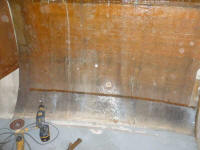
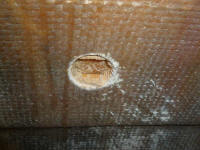
Feeling a bit better about the other parts of the boat, I turned back to the inside of the port side, and cut two larger openings in the inner skin to truly reveal what lay beneath. Each opening was about 6" x 10" or thereabouts, and in both cases the inner skin virtually popped off in its own, with little effort required. The core beneath--again, a combination of balsa and foam in odd mixtures--was clearly water stained and damp, with visible moisture beneath, and there was virtually no bond between the core and the outer skin; I could pull things apart with my hand enough to easily reach inside.
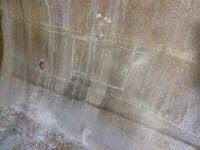
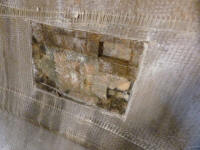
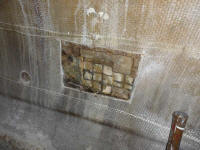
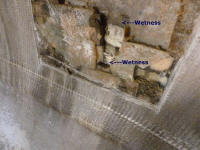
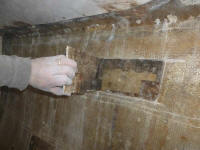
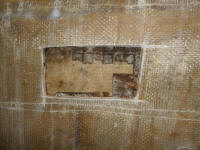

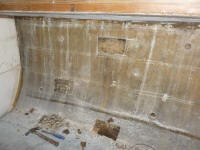
As a final step, my inspection led me back outside, to the port gunwale in this area. This was where I'd noticed cracking filler before, during, and after the paint removal, and removing the toerail earlier in the week had served to highlight this area once again. It looked like the top edge of the outer skin simply wasn't bonded to anything, and some exploratory surgery with a chisel revealed some resin-starved fiberglass that I eventually peeled away to open up a fist-sized hole, just beneath the gunwale in way of the after chainplate. I could see the wet core inside, and the inner skin where it spanned between the hull and deck.
With no way to bring the new (at that repair stage) outer skin up and under the deck as per original, probably the outer skin repair should have overlapped the deck edge and been reinforced in that way; it appeared the new material was somehow just ended near the gunwale, and the remaining seam filled with fairing compound.
The deck edge, where it rested on the hull flange, was chewed up a bit, surely a byproduct of whatever trauma had created the need for this whole repair in the first place.
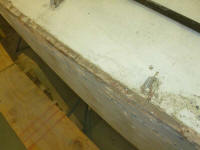
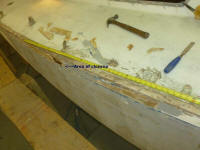
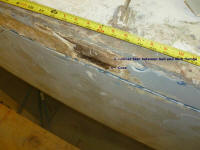
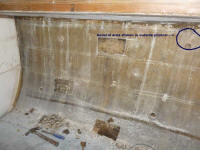
With a grinder, I worked in the area to find out how far back I'd have to go to find sound material, from which any repair would have to begin. Though this was a tentative exploration, I did find that better material existed around the area, but with so much information swimming around my head, I wasn't yet ready to make final pronouncements on the overall condition, though clearly these findings affected the overall scope of the project, and took the opportunity to inform the owner of the new findings while at the same time allowing things to coalesce into a better idea of a plan for going forward. Repairs would be feasible as long as there was good material from which to start, and I'd have to confirm that next.
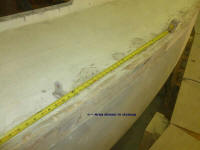

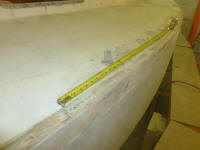
Total Time on This Job Today: 7 hours
